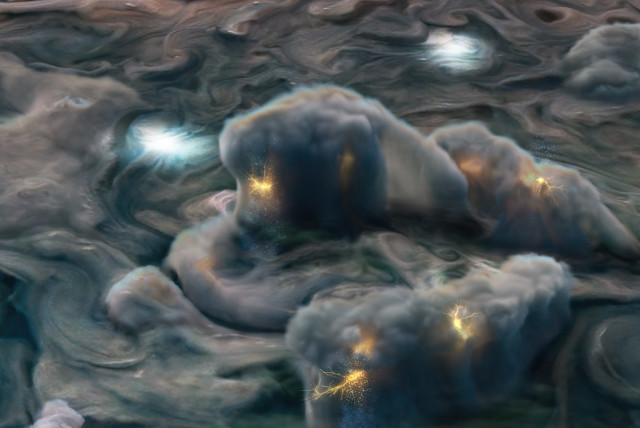NASA’s Juno mission captures lightning on Jupiter

A striking image from NASA's Juno mission shows lightning in Jupiter's atmosphere.
NASA’s Juno mission to Jupiter, which began in August 2011 and has been extended until September 2025, captured an image of a lightning strike near Jupiter’s north pole.
The spacecraft first captured this striking shot on December 20, 2020, when Juno completed its 31st close flyby of Jupiter.
Juno was just about 19,900 (32,000 kilometers) miles above the planet's cloud tops at the time, at a latitude of about 78 degrees as it approached the planet, according to a NASA news release.
Raw data from the JunoCam instrument aboard the spacecraft was processed in 2022 by citizen scientist Kevin M. Gill and thus the final image was developed.
The image, which has gone viral, shows the vibrant green glow of a lightning strike within a massive, swirling vortex.
Striking similarities between Earth and Jupiter
NASA explained that lightning on Earth originates from water clouds and happens most frequently near the equator, while on Jupiter, lightning occurs in clouds containing an ammonia-water solution and happens most frequently near the planet’s poles.
This has given scientists valuable insight into the similarities between lightning on Earth and Jupiter. While they occur in similar ways, they strike in very different locations on each planet.
Jupiter, the fifth planet from the sun and the largest planet in the solar system, is a massive celestial body with a diameter of approximately 88,850 miles (143,000 km). It is predominantly made up of hydrogen and helium, along with small amounts of other gases and its vibrant appearance comes from its characteristic stripes and visible storms.
The discoveries from the Juno mission so far have taught scientists a lot about Jupiter’s atmosphere and interior, such as revealing an atmospheric weather layer that extends past its water clouds, and a deep interior with a dense core of heavy elements.
Over the course of the next few months, Juno's orbits will repeatedly bring it close to Jupiter as the spacecraft passes over the giant planet's side, which will provide additional opportunities for Juno's instruments to capture more lightning strikes as they happen.
Jerusalem Post Store
`; document.getElementById("linkPremium").innerHTML = cont; var divWithLink = document.getElementById("premium-link"); if (divWithLink !== null && divWithLink !== 'undefined') { divWithLink.style.border = "solid 1px #cb0f3e"; divWithLink.style.textAlign = "center"; divWithLink.style.marginBottom = "15px"; divWithLink.style.marginTop = "15px"; divWithLink.style.width = "100%"; divWithLink.style.backgroundColor = "#122952"; divWithLink.style.color = "#ffffff"; divWithLink.style.lineHeight = "1.5"; } } (function (v, i) { });

